The Glass Mobile tests were made from thin strands of glass which were dropped into buckets of water.
The conditions for the glass to survive depended on thickness, temperature and length of shock. the video below displays the process from Hot shop , to making and playing with gravity to allow different strands to intertwine and become one large static mobile.
Although structurally sound, this piece includes prince rupert drops which , when put under pressure at the thin tip can explode. This piece was decided to be too hazardous without annealing. The decision was made to anneal the work.
I wanted this piece to mimic the uncrontrollability of nature, taking inspiration from my trellis series. The main focal points i extracted from the trellis was its repetition and significant plant like structures. Following site based research into nearby woodlands and geological sites of interest. Digital sketches of such places provided context for my interpretation of this outcome.
I wanted the presence of nature taking over, often in unprecidented , extreme ways to reflect off this piece. Whilst the rigidity of the form created structure, I want the viewer to imlicate their own opinions on how this may mimic nature, from birdsnests, coccoons, lightning strikes and tree roots. I found the perception of line in this work to resonate with all of the above and more due to its unplanned presence as individual strands.
In the construction, I focused less on the overall outcome and more on the balance and unplanned perfection of strands resting and interlocking to create a dense lattice .
The image below shows my context which I compiled from multiple sketches done digitally of nature. The context behind these images can be found in below or in ‘site based research’.
The images below demonstrate the process of pulling line work from my site research and compiling it into a form which I then used as inspiration when creating my glass mobile.
Annealing
I decided annealing this piece as one individual lattice to understand its structural capabilities once annealed.
I did this through an annealing cycle on the kiln which would make this piece of glass more compatible with health and safety requirements. The Prince Rupert drops however they are incredibly delicate and were stored separately and later exploded in a safe and controlled environment. This is due to the extreme pressure the glass experienced when it is cooled at such a rapid rate in water. This stress is shown in the piece of glass below. The glass was noticeably more brittle and was not able to withstand as much pressure for my mid module review. I attempted to reinstall this piece however it broke under its own weight Meaning the entire piece shattered on the floor.
This piece had positive feedback from my tutor and is something that I will be testing more thoroughly to understand how I am able to reinstall the mobile safely.
Artwork Description: Pre- Annealed Glass shards, Prince Ruperts Droplets, Fishing Line
Second Attempt
Initially, My second Attempt holds great resemblance to my idea. Natural, free glass shards, differencial in thickness, length and pattern. However as you investigate the piece further, you will notice the lack of prince ruperts droplets. This was decided due to health and safety concerns. Another large difference is the annealing process. This time the pieces were taken straight from water, into the lehr to annealing almost instantly after impact. Whilst preserving the shapes, this seems to have preserved the digidity much more efficiently.
When it came to the reconstruction, I considered the placement of larger, stronger pieces at the top of the threshold, making them less susceptible to break under pressure. Layering these pieces randomly as before whilst considering the delicacy of each individual strand to ensure the durability of the mobile whilst suspended isnt compromised.
Installation in context
Whilst researching for the vertical Gallery, I found various links to my practice roots of arts and crafts and the influence of nature around Grosvenor west.
Lewis F Day , active designer in the arts and Crafts movement in 19th Century Britain inspired motifs adorned to the Modern Lowry Building on campus. These mimic those of the tilings and decorative aspects to Grosvenor west and other motifs around manchester such as the neo gothic inspiration of Manchester town Hall.
As a result of my research, I found it fitting to install my work within the context of surrounding art inspiration and the dominating landscape which justaposed old and new. This worked very well due to the delicacy of these pieces, transporting them would require extreme care and there is a great possibility of damadge to the size and shape of the individual pieces.
The time lapse to the right shows the installation from start to finish. Behind there is context of Grovesner East.
I wanted to install this in a public space to understand how the context of the piece may shift in its placement environment. I was able to understand my work from a new perspective with viewpoints such as Urban buildings modern and old, but also the historic All Saints Park which provided incredible images. with the trees behind , it allowedthe glass mobile to blend into its surroundings whereas with the buildings behind it stood out.
Installation in a dark space
To further understand my final iteration of this glass mobile I wanted to attempt installing it in a darker space. One of the aspects of this work that I really enjoyed was the way that like Sean off of the glass however I felt like in a light space it would be lost against the light walls.
Installing this piece in the dark would allow me to direct my light over the piece, highlighting it in contrast to its surroundings.
I installed this piece the same way that I always have installed it, playing with the perspective of the Spotlight from above below and around the piece.
In this image, the spotlight was placed directly below it, highlighting over all of the intricate details in the glass and providing incredible structural sculptural lines. I established that having the light from underneath would create macro lines on the ceiling where the spotlight shines through providing shadows to the peace. I didn’t want this to be the focal point however it provides a new perspective on the work.
Through investigating this piece in a dark space, I really enjoy how structural the light makes this piece, providing a fresh perspective on the work and it’s delicacy. The way that the light shines onto certain aspects of this piece as it slowly rotates makes it glimmer this to me in bodies. All of these unprecedented phenomenons in nature which are often overlooked in a similar way to my light experiments, I think this piece captures ecological resilience in its existence.
The single component which creates this structural sculpture and it’s existence as a body provides magic for the viewer. The stillness and the peace of this sculpture and the transcendence of these components and its development provide liberation for the material and its context.
Further Installation tests
The reinstallation of my glass mobile was predominantly focusing on light and the source of light in the installation of this piece. I booked out dedo lights to help me understand the intensity of the light on this piece and how the light affects this piece in a dark environment. To begin with the dedo light above the Work pointing down.
I started with intensely and gradually reduced it to understand the aesthetic and how the Work picked up light at lower levels. I found my work held a mysterious element to it in mid to low light levels. It meant that not all of the pieces of glass were visible at all times due to the piece slow slowly rotating. The lights highlighted certain parts of the glass which reminded me of the small beams of sunlight which shine through a window on a cloudy day. I focused on reinstalling my piece wider instead of longer to understand further how the pieces would interact if they were more listed together instead of more lantern however I preferred this piece when it was longer as the smaller spotlight I used later on in the installation didn’t capture the whole piece of work
The following images display the piece at both high and low intensity light levels to provide an understanding as to how the light level affects how the work is viewed. I personally prefer a lower light level.
Degree Show Install
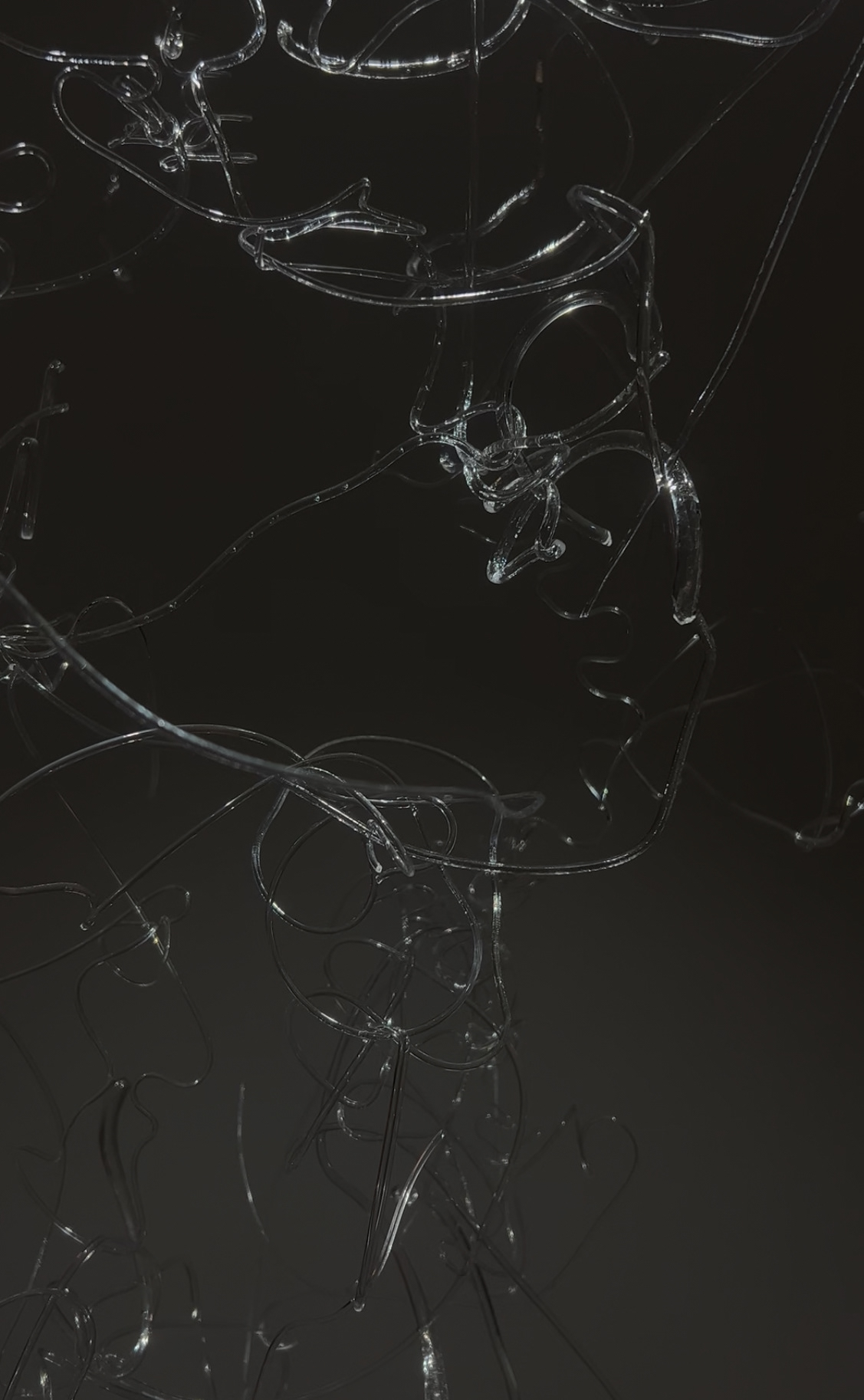
Macro Image of the initial install
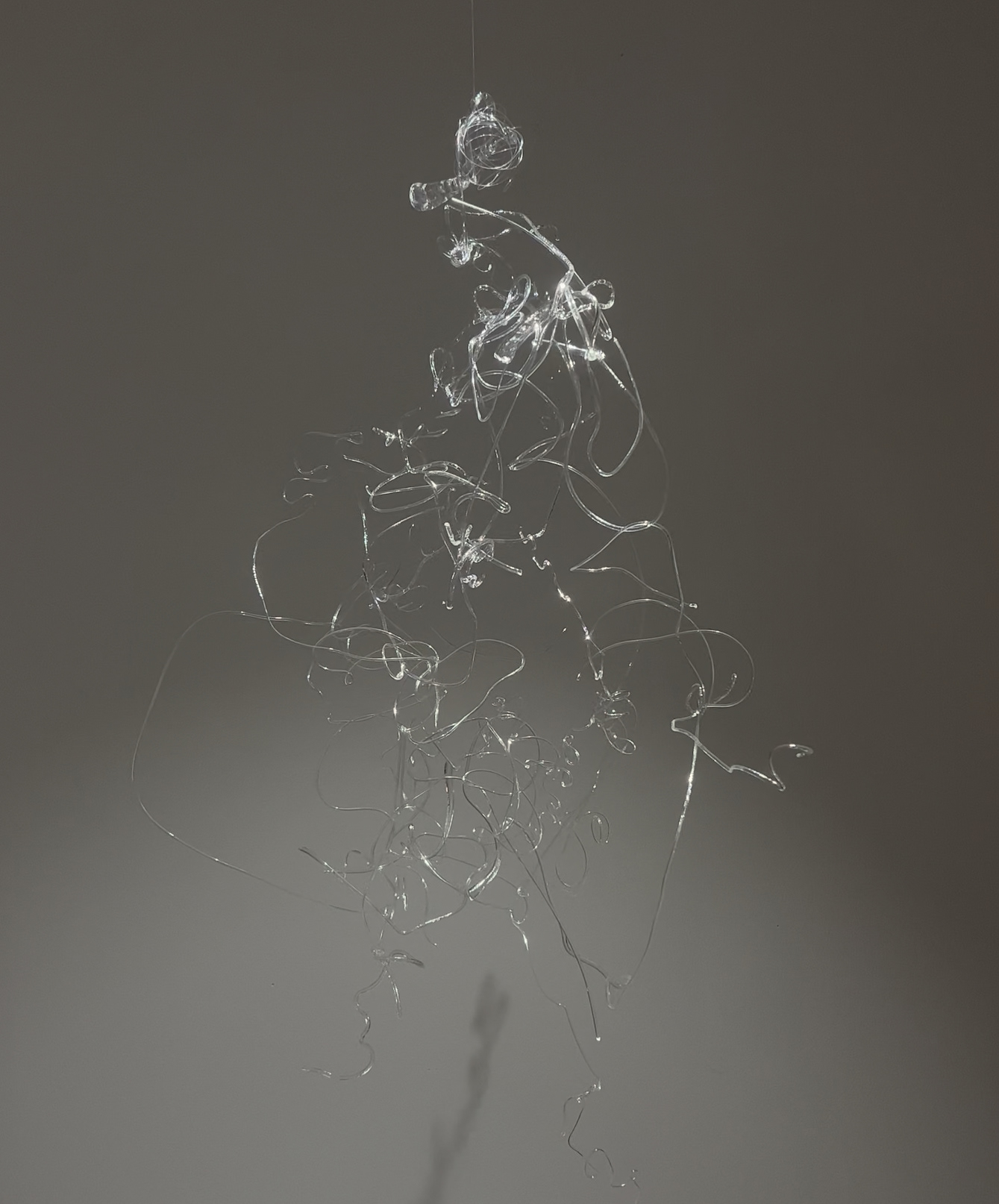
the initial install: stills
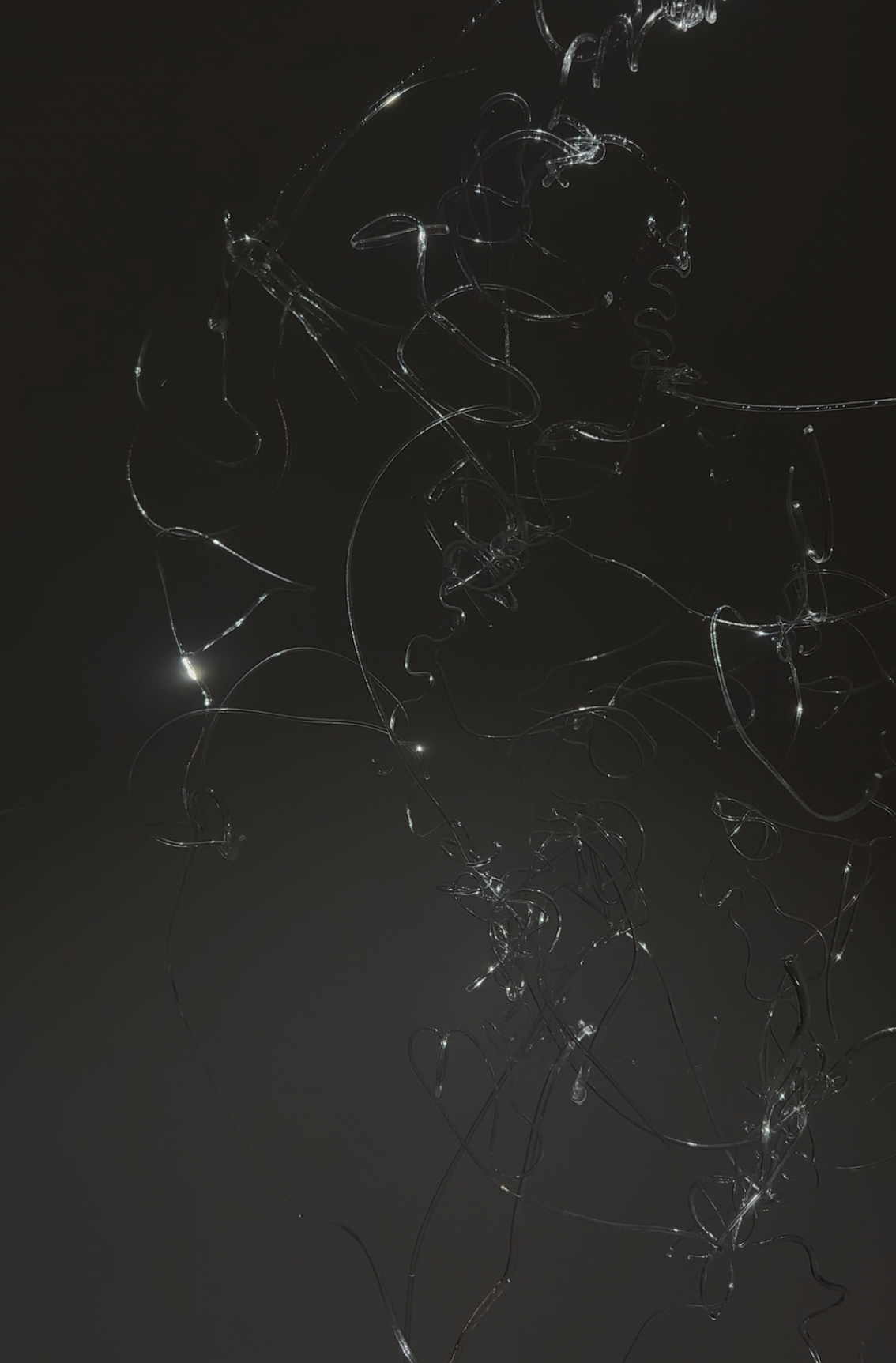
Macro Image of the initial install

the initial install: stills
Above shows the intended outcome of Glass Mobile , compiling over 60 Individual strands of glass into a lattice as displayed above. With 2 days until deadline and less than 24 hours under tension, this piece collapsed leaving only the top structure partially formed. I can imagine from previous tests that the tension on various pieces were the reason for the piece’s collapse.
With less than 48 hours until install deadline , I made the executive decision to re-display the piece to showcase its new state, highlighting the damadge which the delicate strands undertook and the new forms which they presented.
The final installation of this piece saw me lower the tension wire to allow the piece to hang roughly 1.3m off the ground from the top of the piece,
I was advised to drop the height and to raise the floor using a plinth to assist if the piece was to break further in the reconstruction, meaning the fallout of glass wouldnt fall as far as it did from height. Using the plinth as a support and display piece, I used all the salvaged glass shards from the breakage to be displayed in a cyclical manor. These were placed around a smaller hanging mobile which at the centre held a large glass droplet. Above ,I placed a larger glass droplet which I hooked on the wall behind, leading the eye down to the mobile and the fallout below.
This piece will still be displayed in dim lighting, highlighting the mobile and the delicate shards which once held great structure in previous tests and the final piece.
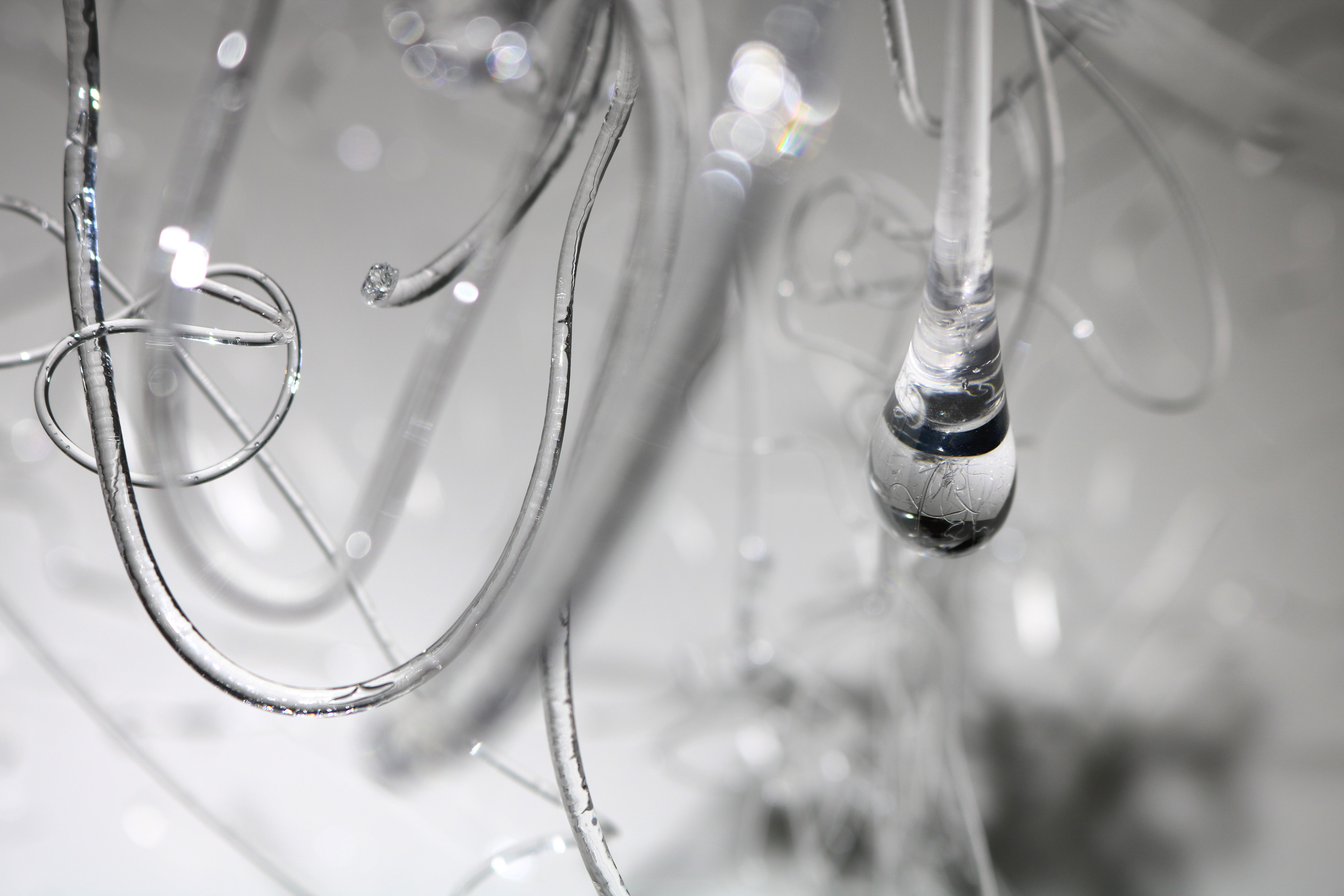
Optical Abberation in the Glass droplet
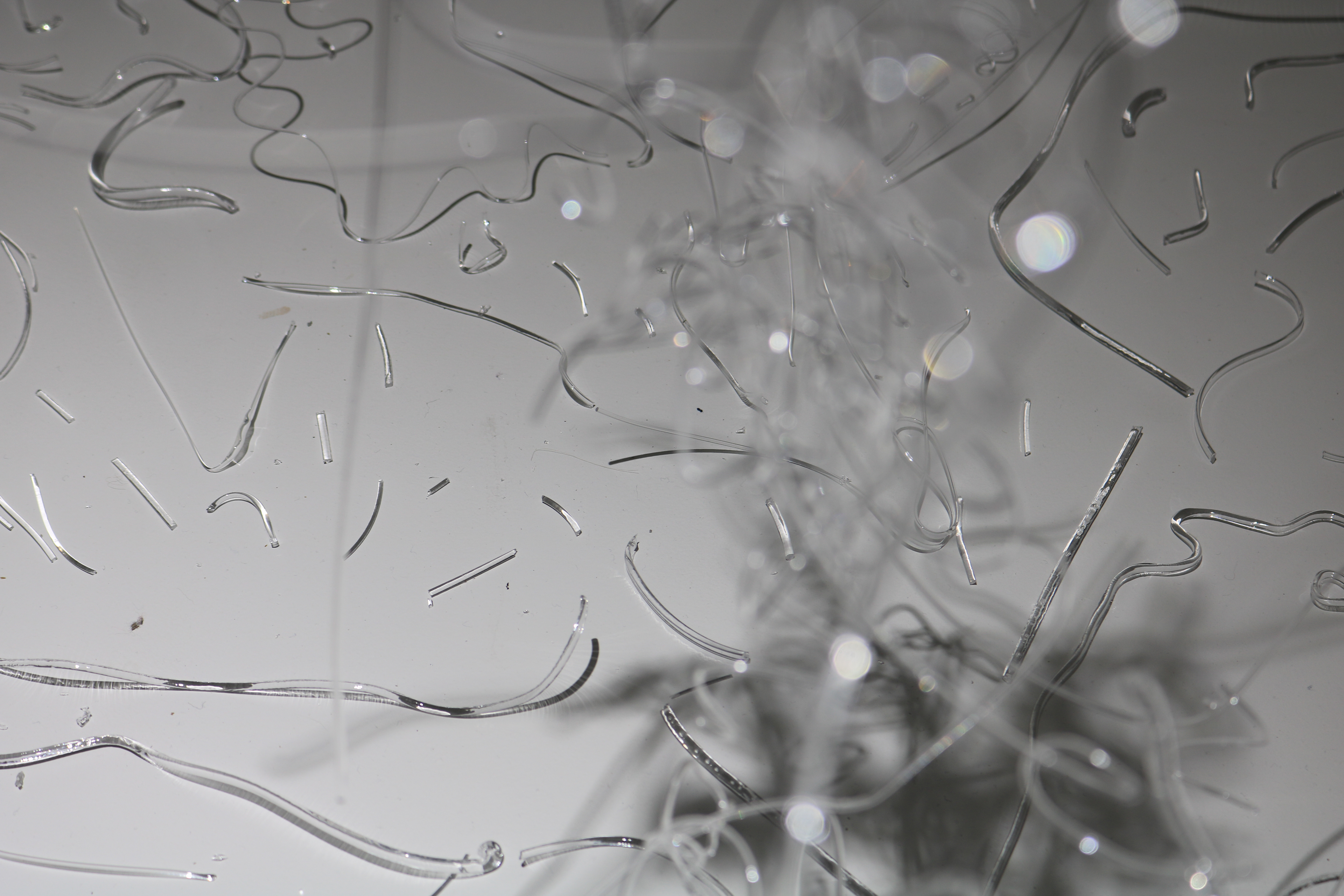
Macro image of the glass lattice, behind the dispersed fallout
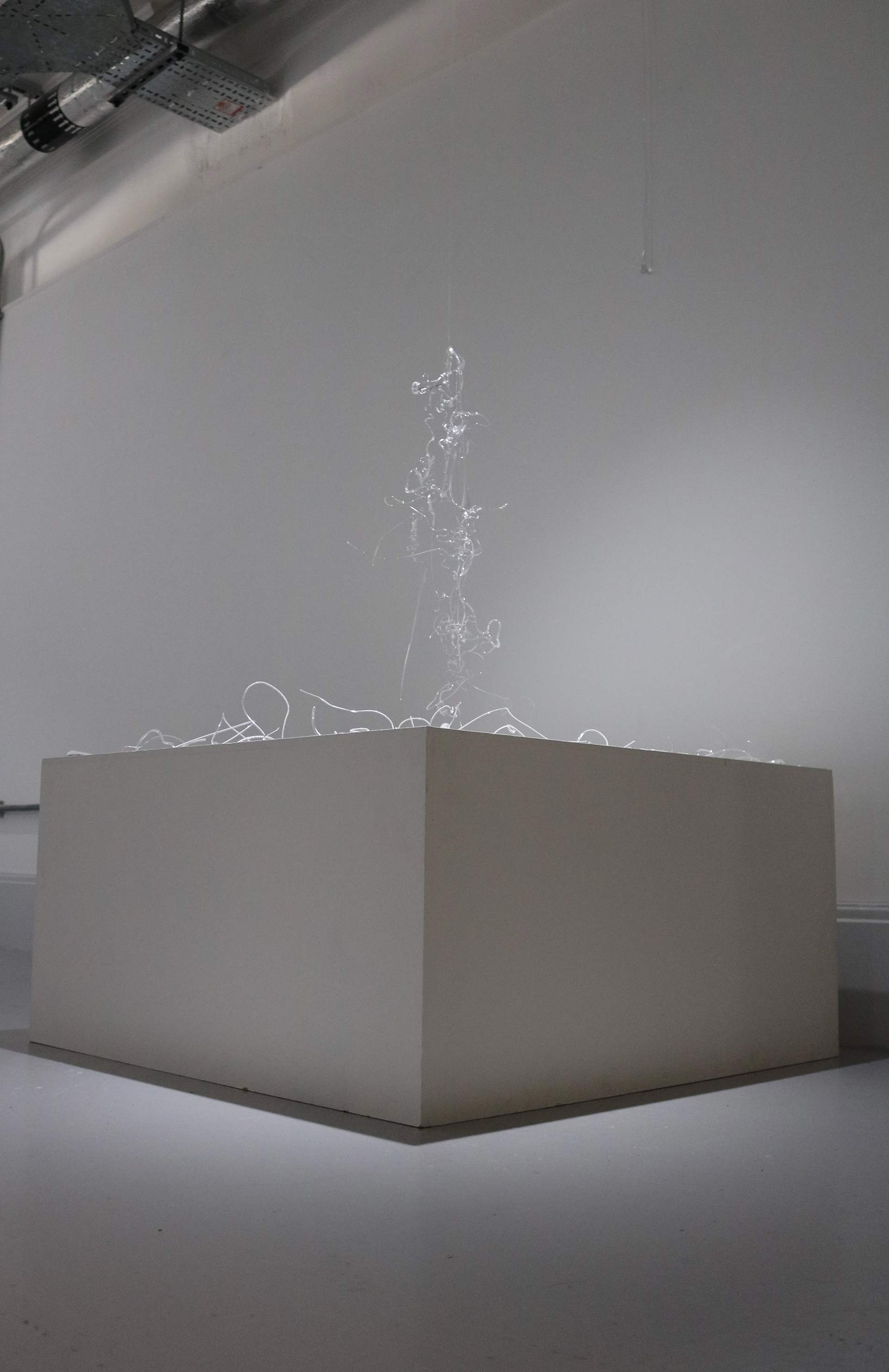
the Glass Mobile with fallout
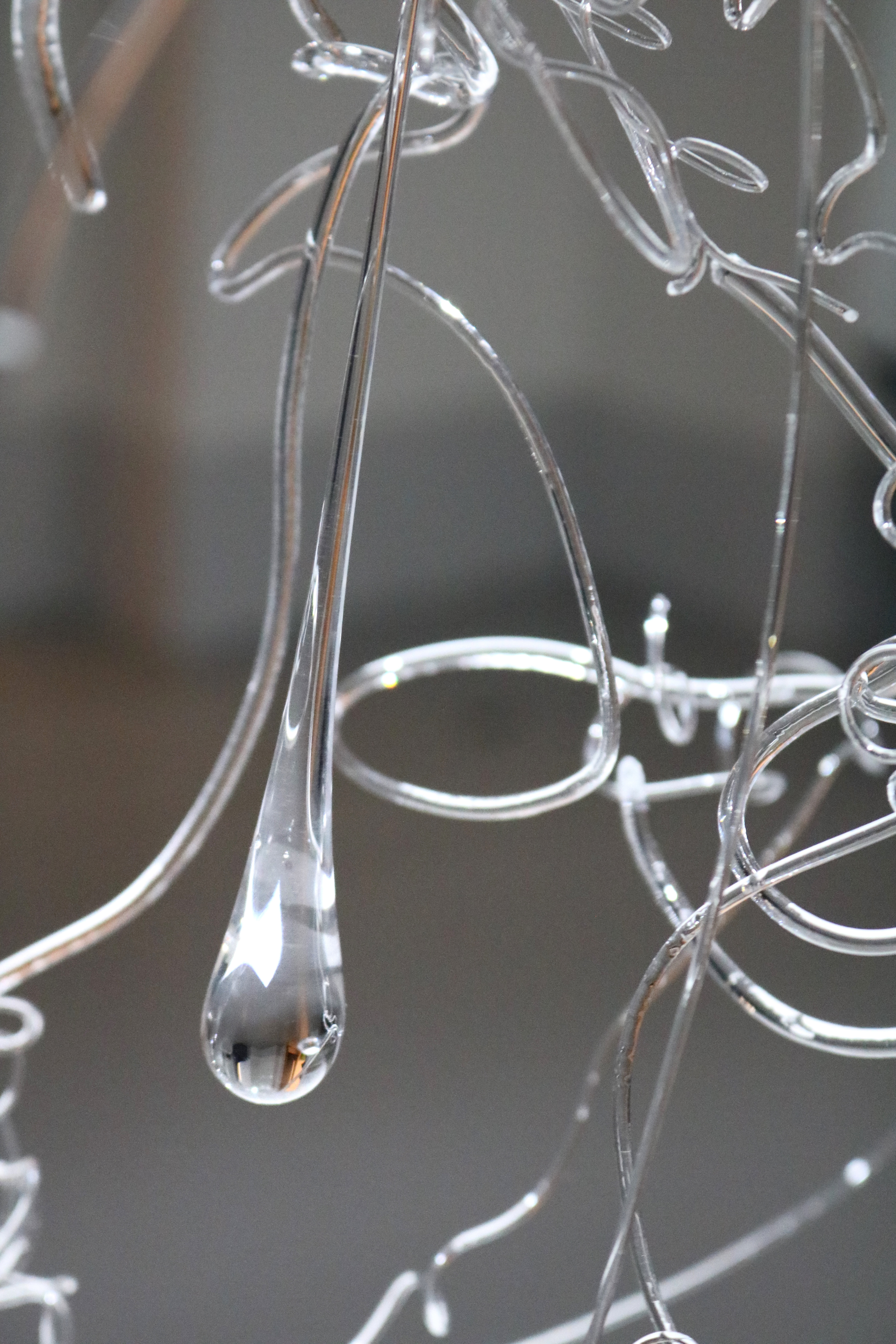
Macro image of the glass droplet
Artwork Description: Annealed Glass shards, Fishing Line
February - April 2025